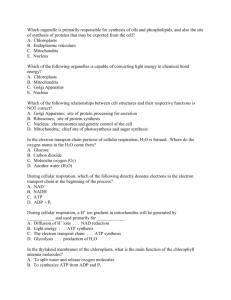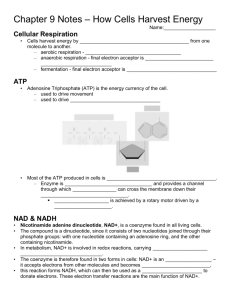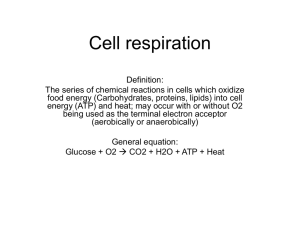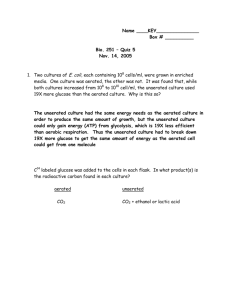Microbiology Microbial Metabolism II Catabolism & Anabolism
advertisement
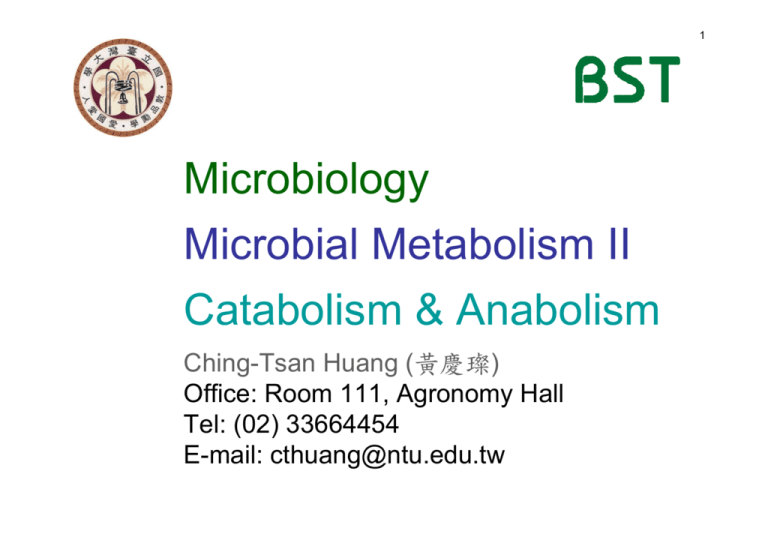
1 Microbiology Microbial Metabolism II Catabolism & Anabolism Ching-Tsan Huang (黃慶璨) Office: Room 111, Agronomy Hall Tel: (02) 33664454 E-mail: cthuang@ntu.edu.tw 2 Anabolism Use of Energy in Biosynthesis Turnover Carefully regulated Catabolism Energy Release and Conservation Provide materials for biosynthesis Amphibolic pathways 3 Amphibolic Pathways 4 Source of Energy for Microorganisms Phototrophy Chemoorganotrophy Chemolithotrophy Chemical Energy Work Chemoorganotrophic Catabolisn Respiration Aerobic Respiration Anaerobic Respiration Fermentation 5 6 Chemoorganotrophic Metabolism Aerobic respiration using oxygen as exogenous electron acceptor yields large amount of energy, primarily by electron transport activity Anaerobic respiration using molecules other than oxygen as exogenous electron acceptors yields large amount of energy, primarily by electron transport activity Fermentation using endogenous electron acceptor often occurs under anaerobic conditions limited energy made available 7 Overview of Aerobic Catabolism 8 Carbohydrate Catabolism: GlucoseÆPyruvate Glycolysis Most common Also called EmbdenMeyerhof pathway Occurs in cytoplasmic matrix of both procaryotes and eucaryotes Generation of NADH ATP synthesis via substrate-level phosphorylation Glucose + 2 ADP + 2 Pi + 2 NAD+ 2 Pyruvate + 2 ATP + 2 NADH + 2 H+ 9 Carbohydrate Catabolism: GlucoseÆPyruvate Pentose Phosphate Pathway provide NADPH as source of electrons 4-carbon sugar for aromatic amino acid synthesis and 5-carbon sugar for nucleic acid synthesis and CO2 acceptor Aerobic or anaerobic 3 Glucose-6-P + 6 NADP+ + 3 H2O 2 Fructose-6-P + Glyceraldehyde-3-P + 3 CO2 + 6 NADPH + 6 H+ 10 Carbohydrate Catabolism: PyruvateÆCO2 Aerobic Use O2 as eacceptor TCA (tricaboxylic acid) cycle or Citric acid cycle or Kreb’s cycle Function Provide carbon skeletons for use in biosynthesis 11 Electron Transport Electron transport chain in the inner membrane of the mitochondrion in the bacterial plasma membrane Electron donors: NADH (3 ATPs) FADH2 (2 ATPs) Electron acceptor: Oxidative phosphorylation: process by which energy from electron transport is used to make ATP Wolinella succinogenes is a nonfermenting bacterium with fumurate as its sole carbon source. It undergoes anaerobic fumerate respiration. 12 Carbohydrate Catabolism: Glucose Æ CO2 13 Fermentations 14 Carbohydrate Catabolism: PyruvateÆCO2 Anaerobic Fermentation No exogeneous eacceptor Use organic molecules as eacceptor ATP formed by substrate-level phosphorylation 15 Lipid Catabolism Lipid Fatty acid + Glycerol Fatty acid β-oxidation 16 Protein and Amino Acid Catabolism Protease Hydrolysis of protein to amino acids Deamination Often occurs by transamination 17 Principles Governing Biosynthesis Macromolecules are synthesized from limited number of simple structural units (monomers) Many enzymes used for both catabolism and anabolism Catabolic and anabolic pathways are not identical, despite sharing many enzymes Breakdown of ATP coupled to certain reactions in biosynthetic pathways Catabolic and anabolic pathways use different cofactors Large assemblies (e.g., ribosomes) form spontaneously from macromolecules by self-assembly 18 Energy Trapping: Photosynthesis Anoxygenic Oxygenic Light reaction light energy is trapped and converted to chemical energy Dark reaction reduce or fix CO2 and synthesize cell constituents 19 Light Reaction Eucaryotes & Cyanobacteria Green & Purple Bacteria PMF Reversed e- flow 20 Photosynthetic Fixation of CO2 Autotrophs obtain energy by trapping light during photosynthesis or by oxidizing or reduced inorganic e- donors Calvin, Calvin-Benson, reductive pentose phosphoraltion cycle in eucaryotes, occurs in stroma of chloroplast in cyanobacteria, some nitrifying bacteria occur in carboxysomes Carboxylation Reduction 6 RuBP + 6 CO2 12 PGA 6 RuBP + Fructose 6-P Regeneration 21 Synthesis of Pyruvate to Glucose Gluconeogenesis: Heterotrophs synthesize sugars by reducing organic molecules Glucoeogenesis Glycolysis 22 Synthesis of Sugars and Polysaccharides Gluconeogenesis synthesize glucose and fructose from noncarbohydrate precursors Sugar nucleoside diphosphates synthesis of other sugars , polysaccharides, and bacterial cell walls ATP + glucose 1-P → ADP-glucose + PPi (glucose)n + ADP-glucose → (glucose)n+1 + ADP 23 Synthesis of Amino Acids Precursor metabolites used as starting substrates carbon skeleton is remodeled amino group and sometimes sulfur are added Nitrogen addition to carbon skeleton is important potential sources of nitrogen: ammonia, nitrate, or nitrogen 24 Synthesis of Amino Acids Phosphoenolpyruvate Oxaloacetate α-ketoglutarate 25 Lipid Synthesis Fatty acid synthesis ACP: acryl carrier protein Triacrylglycerols & phospholipids
